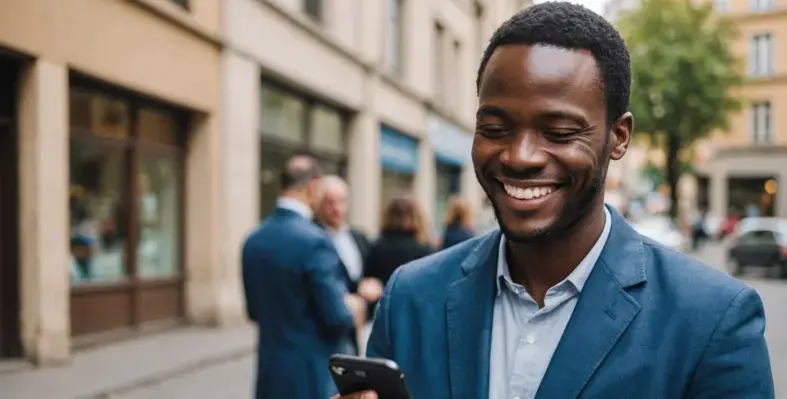The South African mobile telecommunications market is characterised by three mobile network operators (Vodacom, MTN and Cell C) as well as a fourth mobile ‘virtual’ network operator (Virgin).p>The South African mobile telecommunications market is characterised by three mobile network operators (Vodacom, MTN and Cell C) as well as a fourth mobile ‘virtual’ network operator (Virgin).
One of the more popular and fastest growing services has been Mobile Instant Messaging (Mobile IM). Because it uses IP, Mobile IM messaging is considerably less costly to the subscriber than a similar length SMS (Short Messaging Service) message. Additionally, it provides the added advantage to customers of having an instant conversation and for the operator an opportunity to differentiate their service offerings in a competitive market. Mobile IM also carries potential for increasing average revenue per user through the stimulation of IP-based traffic, taking advantage of 3G network investments and functionality.
For this reason, MTN sought to introduce its own version of Mobile IM. Given that an existing, and highly popular, instant messaging service was already available in the South African market, MTN’s objective was to define a solution that would not only deliver an effective service, but would also transcend any shortcomings of the incumbent while delivering more features and benefits to users. Additionally, due to this competitive IM offer, MTN was committed to deploy the new service quickly. The company engaged with Movius Interactive Corporation.
Technology selection and deployment
Leveraging its global footprint and knowledge of the GSM market, Movius partnered with Norwegian software developer Colibria as the ideal technology provider. The solution was selected on the basis of its ability to provide a service that was not only highly attractive to MTN subscribers, but would also integrate easily with the company’s existing messaging and operational systems, including customer care, operations, maintenance and billing systems, SMSC (Short Messaging Service Centre), and MMSC (Multimedia Messaging Service Centre).
In addition, the new Mobile IM handset client is available for all major platforms, including Symbian, Java 2 Micro Edition (and Java Lite for less capable handsets) and a WAP (wireless application protocol) client for non-J2ME handsets (i.e. legacy users). There is also a PC client that many competitive products do not offer which expands the usability options of the service for individual subscribers. Other key features of the Mobile IM solution include:
• Download Manager Server: enables consumers to download and upgrade the mobile IM client software to their handsets and PCs using the Internet, USSD or WAP; the solution automatically recognises the handset and selects the appropriate software and version.
• Statistics Manager Server: collects, stores, exports and displays statistics for events such as the number of IMs sent during a specific period.
• OSS/BSS Integration Services: allows interoperability with all business and support systems, including customer care, operation and maintenance, billing, SMSC, and MMSC.
• Admin Console: secure web-based interface for administrative control of Mobile IM service.
Movius worked closely with MTN’s technical staff to deploy and integrate the service into their infrastructure. Responsible for the implementation of the solution, Movius handled all underlying hardware and software sourcing, configuration and deployment, including integration into operating systems and databases. Careful management was essential to avoid any impact on the company’s existing services as the new offering was brought online. The solution was introduced internally to MTN staff briefly to enable them to become familiar with the service before launching it commercially on 3 December, 2007.
Delivering a superior Mobile IM experience
The Mobile IM solution from Movius is not simply an Internet IM solution with a mobile element but was designed with the mobile consumer’s needs and habits in mind. The new service from MTN, branded noknok, itself was specifically designed to overcome the key shortcomings in existing Mobile IM solutions available in South Africa. The noknok service will interoperate even with handsets that don’t have the noknok client installed on them and must therefore receive SMS or MMS messages.
In addition to usual presence information, such as which contacts are available and which are not, the solution is able to determine which clients can be contacted by noknok and which will be contacted by a message that is instantly converted to SMS or MMS. This ability to communicate across message types increases the appeal of the service. The presence attribute also allows users to share their mood via the presence icon and “context” with a status message - enhancing communication opportunities and conversation starters.
The noknok service deployed Open Mobile Alliance (OMA) Phase 2 specifications that encompass multimedia IM including file sharing and chat rooms. These services enable more than just person-to person conversation, but also allow for anonymous chat and MMS integration.
In order to be successful, MTN recognised the need for its Mobile IM solution to interwork with other carriers. While the GSMA has a global initiative, Personal IM (PIM), to deal with this issue, these interoperability issues are still being finalised.
Therefore, for this to be successful, MTN needed to work directly with its main competitor in the region, Vodacom, so that the noknok service would integrate seamlessly with the Mobile IM services of competing network operators, delivering unrivalled convenience for the customer and allowing for the extension of the Mobile IM community to a far wider user base.
With the competing service notorious for its impact on handset batteries, a further key feature to the Movius solution on which the noknok service is built, is its ‘sleep’ mode. In this mode the handset client lies dormant until it receives a signal from a party wishing to exchange messages. The service is geared to drive a superior user experience while driving up ARPU with features such as the ability to express emotions, set moods and communication contexts, initiate one-to-many communications, facilitate chatrooms and other more bandwidth-intensive file exchanges including picture messaging. With a PC client also available, noknok extends Mobile IM to the PC, enabling and stimulating communication between a PC - which is preferred by many for text input - with mobile handsets, also enabling SMS and MMS from PC.
The future
MTN believes the future is not simply Mobile IM but actually the building of mobile communities. Mobile IM can provide the foundation for additional services such as banking and content purchases. It also enables the creation of customised chat rooms based on a subscriber’s interests and alliances.
Additionally, as MTN South Africa already counts the number of noknok users in the hundreds of thousands - and steadily growing - the organisation is considering extending the service further into its service offerings in other African countries. Furthermore, together with Movius, the company is seeking to introduce elements of unified communication through the noknok service, with integration with other popular messaging platforms expected to accelerate usage and drive Internet Protocol driven ARPU.






















